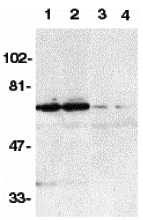Anti-DR6 (NT) Antibody (2157)
$445.00
SKU: 2157
Categories: Antibody Products, Apoptosis Antibodies, Products
Overview
Product Name Anti-DR6 (NT) Antibody (2157)
Description Anti-DR6 (NT) Rabbit Polyclonal Antibody
Target DR6 (NT)
Species Reactivity Human
Applications ELISA,WB
Host Rabbit
Clonality Polyclonal
Isotype IgG
Immunogen Peptide corresponding to aa 42-56 of human DR6 precursor (accession no. AF068868).
Properties
Form Liquid
Concentration Lot Specific
Formulation PBS, pH 7.4.
Buffer Formulation Phosphate Buffered Saline
Buffer pH pH 7.4
Format Purified
Purification Purified by peptide immuno-affinity chromatography
Specificity Information
Specificity This antibody recognizes human DR6 (68kDa).
Target Name Tumor necrosis factor receptor superfamily member 21
Target ID DR6 (NT)
Uniprot ID O75509
Alternative Names Death receptor 6, CD antigen CD358
Gene Name TNFRSF21
Gene ID 27242
Accession Number NP_055267
Sequence Location Cell membrane, Single-pass type I membrane protein
Biological Function Promotes apoptosis, possibly via a pathway that involves the activation of NF-kappa-B. Can also promote apoptosis mediated by BAX and by the release of cytochrome c from the mitochondria into the cytoplasm. Plays a role in neuronal apoptosis, including apoptosis in response to amyloid peptides derived from APP, and is required for both normal cell body death and axonal pruning. Trophic-factor deprivation triggers the cleavage of surface APP by beta-secretase to release sAPP-beta which is further cleaved to release an N-terminal fragment of APP (N-APP). N-APP binds TNFRSF21; this triggers caspase activation and degeneration of both neuronal cell bodies (via caspase-3) and axons (via caspase-6). Negatively regulates oligodendrocyte survival, maturation and myelination. Plays a role in signaling cascades triggered by stimulation of T-cell receptors, in the adaptive immune response and in the regulation of T-cell differentiation and proliferation. Negatively regulates T-cell responses and the release of cytokines such as IL4, IL5, IL10, IL13 and IFNG by Th2 cells. Negatively regulates the production of IgG, IgM and IgM in response to antigens. May inhibit the activation of JNK in response to T-cell stimulation. {PubMed:21725297, PubMed:22761420, PubMed:9714541}.
Research Areas Apoptosis
Background Apoptosis is induced by certain cytokines including TNF and Fas ligand of the TNF family through their death domain-containing receptors, TNF-R1 and Fas. Several novel death receptors including DR3, DR4, and DR5 were recently identified. A new death domain-containing receptor in the TNF receptor family was recently described and designated DR6. Like TNF-R1, DR6 interacts with death domain-containing adapter molecule TRADD. Overexpression of DR6 induces apoptosis and activates NF- B and JNK. DR6 is widely expressed in human tissues and cell lines. The ligand for DR6 is under investigation.
Application Images


Description Western blot analysis of DR6 in K562 (1,3) and Raji (2,4) whole cell lysate in the absence (1,2) or presence (3,4) of blocking peptide (Catalog no. 2157P) with DR6 antibody at 1:500 dilution.
Handling
Storage This antibody is stable for at least one (1) year at -20°C. Avoid multiple freeze-thaw cycles.
Dilution Instructions Dilute in PBS or medium which is identical to that used in the assay system.
Application Instructions Immunoblotting : use at 2ug/mL.
Positive control: Whole cell lysate from K562 or Raji cells.
These are recommended concentrations.
Enduser should determine optimal concentrations for their applications.
Positive control: Whole cell lysate from K562 or Raji cells.
These are recommended concentrations.
Enduser should determine optimal concentrations for their applications.
References & Data Sheet
Data Sheet  Download PDF Data Sheet
Download PDF Data Sheet
 Download PDF Data Sheet
Download PDF Data Sheet


